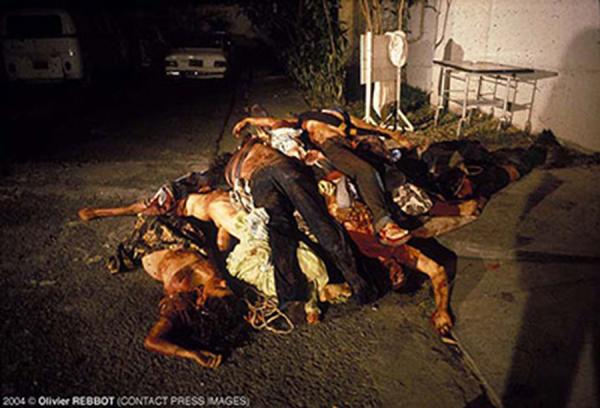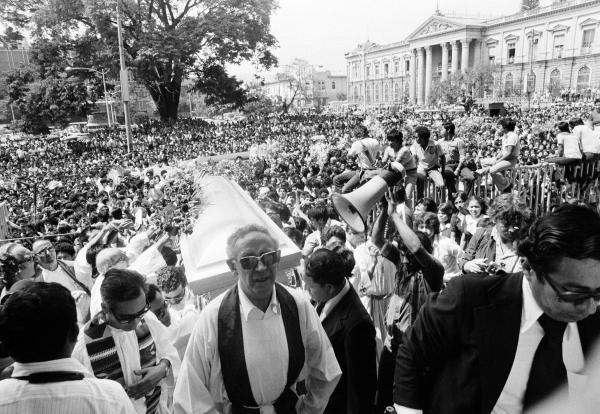U.S. President Biden has repeatedly labeled Russian President Putin a “war criminal.” Biden and other U.S. officials mouth deep outrage at the suffering of the Ukrainian people. They talk somberly about what is the best international venue to hold Nuremburg-style war crimes trials for Russian leaders. Ukrainian President Zelensky even told the UN Security Council that Russia’s actions in Ukraine constitute “the most heinous war crimes of all time since the end of World War II.”
Russia’s invasion of Ukraine is in fact a criminal violation of the sovereignty of another country, and it is fairly clear that its conduct of the war has involved serious war crimes, such as bombardment of civilian population centers like Kyiv, Mariupol, and Kharkiv. And there are reported cases of use of “cluster munitions”—bombs or shells that break up into smaller explosives that disperse over a wide area. (See "Vietnam War” section below for more on cluster munitions.)
There are also allegations of rape, torture and murder, which at this point are largely undocumented and need to be investigated.
But as grievous as these crimes are, and even assuming that all the so-far-unproven allegations turn out to be true, they pale in comparison to the crimes of the U.S. imperialist war machine (including the CIA) that Biden represents and leads, and which Zelensky is closely allied with.
Below is a partial listing and brief description of some of the most egregious war crimes of the U.S. and its close allies in the period that Zelensky focuses on—“since the end of World War II.” These were crimes committed internationally, outside the U.S. borders (i.e., we have not included here crimes against humanity committed against Black people, Native people, and others within the U.S.).
Part 1 covered the period 1948-1979. Part 2 below covers the period 1980-1992.
***
1980 - 1992
Aiding in Torture, Rape and Massacre of Unarmed Civilians; Killing of Peaceful Protesters; Assassination of Political Opponents.
El Salvador Civil War
From 1980 to 1992, civil war raged in the Central American country of El Salvador. Most Salvadoran people lived in desperate poverty and without any political rights, terrorized by the military, police, and a network of secret death squads tied to the government and to the U.S. CIA.1 Wealth, and power, were heavily concentrated in a tiny elite of large landowners and other “oligarchs.”2
The anti-government forces were led by the Farabundo Martí National Liberation Front (FMLN), which had support among broad sections of the Salvadoran people, including former liberals, progressive Catholics, trade unionists, and leftist guerrilla groups. It was also supported by Cuba and the Soviet Union.
The U.S. was the government’s main support, training and providing “advisors” to the Salvadoran military, along with at least four billion dollars in aid3—one billion directly to the military, and another three billion in “economic aid” to prop up the dictatorship.
Here is some of what the U.S. was backing:
Attacks on peaceful protests:
- On January 22, 1980, about 100,000 protesters gathered in San Salvador to commemorate a past government massacre. A plane doused them with insecticide, then National Guard and police opened fire, reportedly killing 67 protesters and wounding 250.4
- On March 17, 1980, government forces killed at least 54 people in an effort to crush a general strike.5
Torture:
- In 1982 a former Salvadoran soldier gave detailed descriptions of the brutal torture and murder of a 13-year-old girl and 17-year-old boy by Salvadoran soldiers. He said that U.S. military advisors were present for the actual torture (though not the murders), and training in torture techniques, and did not object to any of it.6
- The Salvadoran military routinely dropped “suspects” from helicopters into the sea, and slashed victims faces so they would be unrecognizable. Solders were trained to “not feel pity of anyone,” to kill anyone, including women, children and the elderly, “who put themselves in front of you,” and that “the majority of peasants are guerrillas.”7
Murdering Priests and Nuns:
- Because significant parts of the Catholic Church sympathized with the FMLN, the death squads raised the slogan “Be a patriot, kill a priest.”
- On March 24, 1980, Archbishop Oscar Romero was gunned down while delivering Mass. In a sermon the day before he had called on the military “in the name of God, Stop the repression.”8 This assassination was directed by Roberto D'Aubuisson, a death squad leader with close ties to the U.S., and the U.S. was aware of his role.9
- Romero’s funeral was also attacked—at least 40 mourners were killed.10
- In December 1980, four American church women (three nuns and a lay worker) were stopped by Salvadoran soldiers, raped, and murdered. When this came out, the U.S. ambassador to the UN tried to justify the murders, saying “The nuns were not just nuns. They were political activists on behalf of the Frente [FMLN].”11
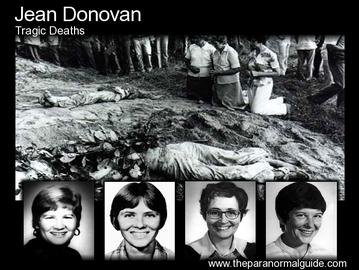
Grave of four nuns murdered in El Salvador.
- In November 1989, an elite commando unit killed six Jesuit priests in their home, along with their housekeeper and her teenage daughter.12
Massacres and “Disappearances” of Peasants:

Massacre in the village of El Mozote, El Salvador, December 11, 1981.
- In December 1981, soldiers of the U.S.-trained Atlácatl battalion tortured and slaughtered at least 986 people, including 552 children and 12 pregnant women, in the village of El Mozote. Women were raped, babies had their skulls bashed in, older children were decapitated.13
- By the end of the war, an estimated 71,000 people had been killed.14 More than a million people—roughly one fifth of the population—were displaced from their homes.15
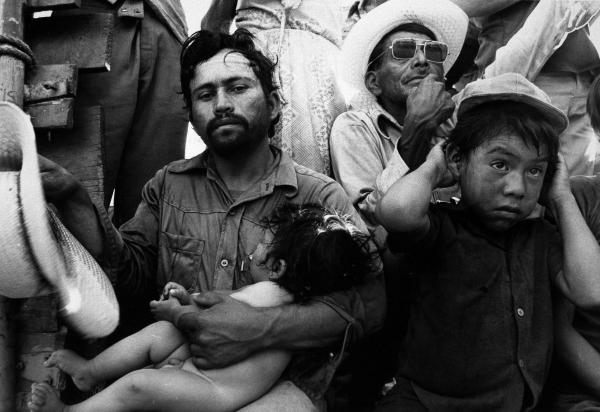
Salvadorans flee from their homeland. By the end of the war, more than a million people—roughly one fifth of the population—were displaced from their homes. Photo: AP
In 1987, El Salvador’s president Jose Duarte traveled to Washington to see U.S. president Reagan. Reagan praised Duarte’s “steady hand at the helm.” Duarte then kissed the American flag while Reagan and other officials clapped.16
1982-83:
Enabling and Supporting Genocide Against Mayan People; Torture; Massacres of Civilians.
Guatemala: Ríos Montt and Ronald Reagan
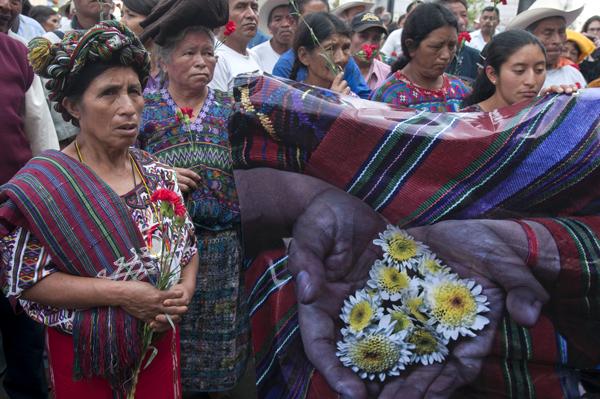
Women protest after a judge ordered the suspension of the genocide trial against Guatemala's former dictator General Efrain Rios Montt. Photo: AP
A U.S.-backed coup in 1982 brought a Christian fascist general—José Efraín Ríos Montt—to power. Under Montt (and continuing after), the Guatemalan military escalated the genocidal civil war that began with the U.S.’s 1954 coup in Guatemala (See Part 1 of this article.) Montt’s forces systematically destroyed more than 600 Maya (indigenous) villages. Seventy-five thousand people, overwhelmingly Maya, were slaughtered in less than two years.17
Sixteen months later Montt was deposed and eventually put on trial. Francisco Velasco, one of dozens of Mayan witnesses, testified about a 1982 army raid on his village in which soldiers killed 33 Ixil (a Mayan people), including Velasco’s 12-year-old daughter: “They opened up her chest, they ripped out her heart.”18
Montt was convicted of genocide and other crimes. But the U.S. saw things “differently.” The U.S. Directorate of Intelligence described Montt’s regime as “the Spiritual Rebirth of Guatemala.”19 In December 1982, U.S. President Reagan met personally with Montt and declared him “a man of great personal integrity and commitment.”
At that time the U.S. was well aware of the ongoing genocide.20
July 3, 1988:
Missile Attack on Civilian Aircraft Over International Waters.
Shoot-down of Iran Air Flight 655
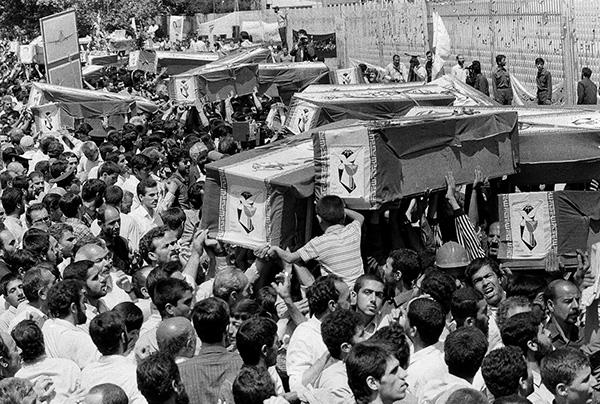
Iranians carry coffins of loved ones killed when a U.S. ship shot down their passenger plane, July 7, 1988. Photo: AP
On July 3, 1988, an Iranian passenger plane was making a routine flight across the Persian Gulf with 290 passengers and crew aboard, flying in designated civilian air corridors, and communicating on normal civilian radio channels. Without warning, the U.S.S. Vincennes, a huge warship equipped with state of the art radar and other equipment, fired two cruise missiles that destroyed the plane, killing everyone on board.21
The U.S. told lie after lie about what happened, including claiming that the Vincennes could not distinguish a large, slow airbus-style passenger plane for a much smaller and faster F-14 fighter jet. These lies were systematically refuted by the pro-military U.S. Naval Institute.22
But neither facts nor the loss of 290 innocent lives mattered to the U.S. rulers: As President George H. Bush put it, “I will never apologize for the United States of America. Ever. I don’t care what the facts are.”23
About two years later, Bush awarded the captain of the Vincennes the Legion of Merit medal for “Outstanding Service.”24
1989-1990
Invasion of Sovereign Country; Destroying Civilian Population Center; Deposing a Foreign Leader to Install a “Friendly” Regime.
Invasion of Panama
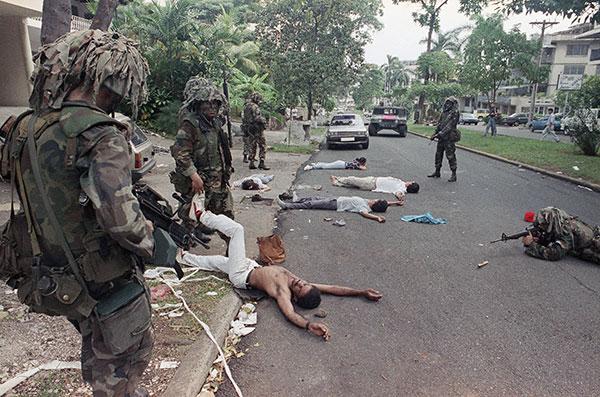
On December 20, 1989, the U.S. military invaded Panama with 27,500 troops and 300 aircraft, killing thousands of civilians. Photo: AP
On December 20, 1989, 27,000 U.S. troops invaded Panama, aiming to overthrow and arrest Panamanian leader Manuel Noriega. For decades Noriega had been a CIA operative, U.S. flunkey and drug trafficker, entrusted by the U.S. to maintain its domination of Panama. Noriega had played a key role in funneling weapons from the U.S. to the Nicaraguan “Contra” forces (see Part 1 of this article), among other “services.”
But by the late 80s, the U.S. had summed up that Noriega was not loyal or reliable. This was especially problematic to the U.S. as the strategically important Panama Canal was slated to officially change from U.S. to Panamanian control. So the U.S. determined that Noriega had to go.25,26
Noriega’s strongest support was in Chorrillos, an impoverished neighborhood of 25,000. U.S. troops stormed through Chorrillos, mercilessly setting fire to wood-framed residential buildings, shooting people on sight, crushing people with their tanks, and burying victims in mass graves. When they were finished half the neighborhood was completely destroyed—survivors called it “Little Hiroshima.” About 5,000 Panamanians were dead.27
The U.S. deposed the pro-Noriega president and swore in a new, pro-U.S. “president” on a U.S. military base. Noriega was arrested and tried in the U.S.—something that is completely illegal under international law and was even protested by America’s European allies.28
To this day Panama bears the scars of the invasion’s death and destruction, and of subsequent U.S. domination.29

